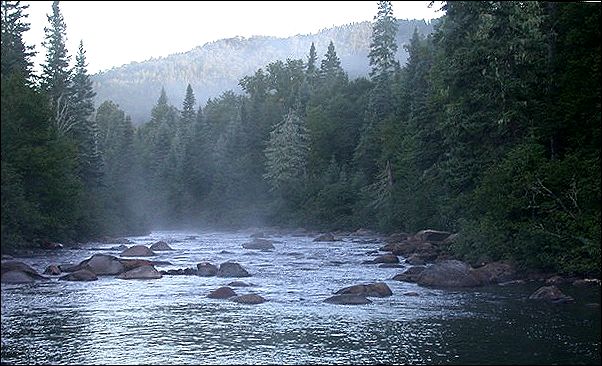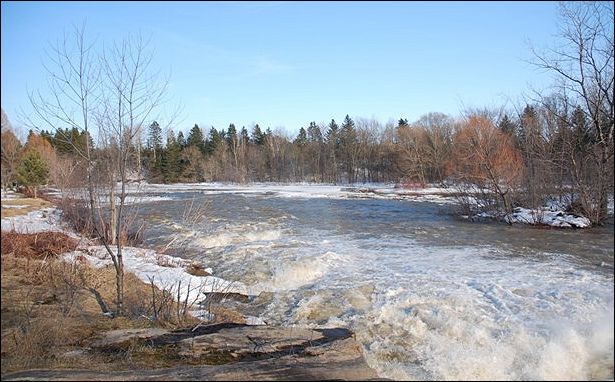Reading the Water - Part 1 of 3
(Think like a trout – think like a bug).
By Chris Chin
Y'all (mostly) know thatI like to sight fish. That is to say, I prefer
to present the fly to a specific fish or group of fish, rather than
prospecting "blindly." That said, there are many occasions when
there is just no way to look or see "into" the water to see if fish
are there. Where to fish then?
I usually fish in rivers, so the task is much easier than on still waters.
On a river (or brook), fish (I mean trout, I haven't fished for many
other species) will hold in lies. There are three types of lies a trout
will hunker down in:
1. Holding lies: trout like these because they provide cover from
predators as well as some sort of hydraulic effect where they can
hold without expending too much energy;
2. Feeding lies: trout will move into these positions because
there is "food" coming by;
3. Prime lies: these positions offer protection from predation,
good hydraulics to hold steady in and FOOD!
In order to better understand why lies are important to be able
to identify, let's go back to a bit of "fish psychology". In other
words, to find trout …well, think like a trout.
Resident trout in a brook or river live a constant balancing
act between eating to create (or store) energy and moving
about (or not) thus expending energy. If a trout is going to
move to "catch" something, it must gain more energy from
the meal than it expends chasing after it! At the same time,
trout fall prey to a variety of beasts.
In order to protect themselves from predation and rest, trout
look to "hide" under of near obstacles, in deep dark water
or in water which has a broken or riffled surface. Identifying
holding lies is usually pretty easy. They are the placed we
often cast to: Close in to the bank, near log jams, deep pools
or next to the boat dock.
Feeding lies are a bit more complicated when we don't see
activity on the surface. To find feeding lies, we need to look
at a bit of stream biology (just a bit).
Now if you were a "bug", where would you live? Think like a
bug. You eat algae, other bugs or even small fish. To eat algae,
you need really shallow water (to get sun light) and you need
living space (like in the spaces between nice gravel). A moderate
current is nice too, so you can crawl about without being ripped
off of the bottom by the water flow. In fly fishing jargon, this ideal
place to live would be a "riffle". Nice even current, gravel and rock
strewn bottom. Water ranging from 10 inches to a couple of feet deep.
So a riffle is probably too shallow for a trout to be comfortable in.
Not deep enough for cover, but there should be lots of food there.
If I were a trout, I'd move up into a feeding lie in a riffle when there
is real bug activity and/or at dawn or dusk.
If I were looking for a prime lie, I'd set myself up at the end of a
riffle where it spews into a pool. There, as a trout, I'd have the
best of both worlds: Slower current to hold in, deeper water for
cover and bugs 'n stuff tumbling out of the riffle.

The riffle tumbling out of the #4 into the pool on my home waters
Next week…seams and pools.
How would you read this section of water?

The pool in high water – my back yard
~ Chris Chin, St-Severin de Proulxville, Quebec.
About Chris:
Chris Chin is originally from Kamloops,
British Columbia. He has been fly fishing
on and off ever since he was 10 years old.
Chris became serious about the sport within
the last 10 years.
"I'm a forest engineer by day and part time
guide on the Ste-Marguerite River here in
central Quebec. I've been fishing this river
for about 10 years now and started guiding
about 5 years ago when the local guide's
association sort of stopped functioning."
Chris guides mostly for sea run brook trout
and about 30% of the time for Atlantic Salmon.
"I often don't even charge service fees, as
I'm more interested in promoting the river
than making cash. I like to get new comers
to realize that salmon fishing is REALLY for
anyone who cares to try it. Tradition around
here makes some of the old clan see Salmon
fishing as a sport for the rich. Today our
shore lunches are less on the cucumber sandwich
side and more toward chicken pot pie and Jack
Daniel's."
Chris is 44 years old as of this writing. He
is of Chinese origin although his parents were
born and raised in Jamaica.
To learn more about the Ste-Marguerite River,
visit Christopher's
website. You can email Chis at: Flyfishing.christopher@gmail.com.
Our Man In Canada Archives
|

